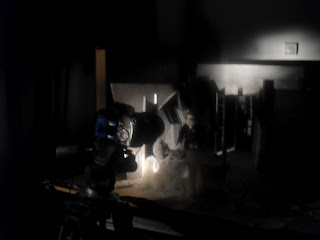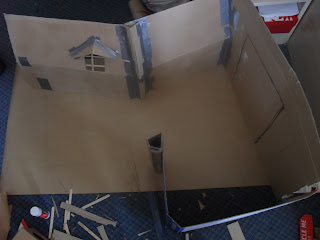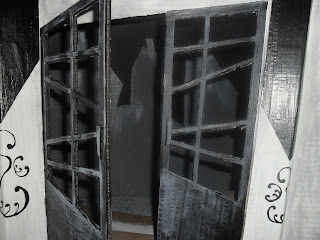I know I should look forward to this part the most seeing as I'm an (BA) Animation student but saying that I've come to realise that building and design is what I want to do, mainly because I can't animate to save my life. Well that's slightly over dramatic but it's not far from the truth. Nether the less I tried my hardest when it came to set up, lighting and filming. I spent nearly 3 weeks solid animating my film only to find that it all needed to go and I had to start from scratch.
Due to this setback I only had 2 weeks left to reanimate nearly everything and edit it as well. I was up to the challenge and changed my storyboard slightly to make things that much easier for me. I also had the advantage of knowing what I could improve and where.
This shadow shot has been the vain of my life. What was a really nice, Nosferatu type shot when filmed came out way to exposed when exported. After trying and failing to export it several more times I tried to reanimate it. Three attempts, one computer shut down and nearly every exported film resulting in the shot turning to blank film later I gave up, choosing instead to use the crappy over exposed shot and hoping that I could edit it somehow. I couldn't by the way.
Other shots were much nicer. I had several walking shots in my film and didn't have the stamina to do a walk cycle each time so "cleverly" animated the shots in different angles or close ups so I didn't have to shoot the whole body.
A lot of time was spent setting my shots up, such as getting the camera angles and lighting right before animating even started. On most of my shots I'm pleased with how they turned out but others I'm not to fussed on and would have liked to redo.
Some of the animations I spent whole days on had to be scrapped in the end as they came out way too exposed and had to be replaced with stills, which I'm not really happy about but they seem to work.
During the editing stage of my animation I had to change everything to black and white so that it would fit my silent movie type idea. When the footage was all edited in that way I found it looked too crisp and clear for a dark 1920's stlye film so I added some Noise over the top using Video Effects to make it kind of look like old footage. It makes the film look a little better but it really isn't the way I wanted it to turn out. I didn't even have time to get rid of any of the rigs in some shots.
My final film isn't exactly how I imagined it but I think it has turned out as well as it could in the short time I had because of having to redo most of it. I'd like to post it on here but I'm not exactly pleased with it so may conveniently not get round to it any time soon.
My final film isn't exactly how I imagined it but I think it has turned out as well as it could in the short time I had because of having to redo most of it. I'd like to post it on here but I'm not exactly pleased with it so may conveniently not get round to it any time soon.






































